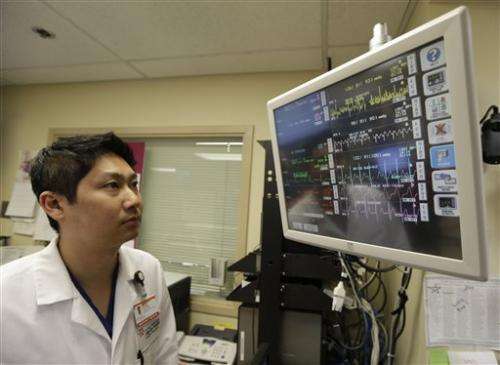Emergency room visits after energy drinks on rise (Update)

A new U.S. government survey suggests the number of people seeking emergency treatment after consuming energy drinks has doubled nationwide during the past four years, the same period in which the supercharged drink industry has surged in popularity in convenience stores, bars and on college campuses.
From 2007 to 2011, the government estimates the number of emergency room visits involving the neon-labeled beverages shot up from about 10,000 to more than 20,000. Most of those cases involved teens or young adults, according to a survey of the nation's hospitals released late last week by the Substance Abuse and Mental Health Services Administration.
The report doesn't specify which symptoms brought people to the emergency room but calls energy drink consumption a "rising public health problem" that can cause insomnia, nervousness, headache, fast heartbeat and seizures that are severe enough to require emergency care.
Several emergency physicians said they had seen a clear increase in the number of patients suffering from irregular heartbeats, anxiety and heart attacks who said they had recently downed an energy drink.
More than half of the patients considered in the survey who wound up in the emergency room told doctors they had downed only energy drinks. In 2011, about 42 percent of the cases involved energy drinks in combination with alcohol or drugs, such as the stimulants Adderall or Ritalin.
"A lot of people don't realize the strength of these things. I had someone come in recently who had drunk three energy drinks in an hour, which is the equivalent of 15 cups of coffee," said Howard Mell, an emergency physician who serves as a spokesman for the American College of Emergency Physicians.
The findings came as concerns over energy drinks have intensified following reports last fall of 18 deaths possibly tied to the drinks—including a 14-year-old girl who died after drinking two large cans of Monster Energy drinks. Monster does not believe its products were responsible for the death.
Two senators are calling for the Food and Drug Administration to investigate safety concerns about energy drinks and their ingredients.
The energy drink industry says its drinks are safe and there is no proof linking its products to the adverse reactions.
The Substance Abuse and Mental Health Services Administration's survey was based on responses it receives from about 230 hospitals each year, a representative sample of about 5 percent of emergency departments nationwide. The agency then uses those responses to estimate the number of energy drink-related emergency department visits nationwide.
The more than 20,000 cases estimated for 2011 represent a small portion of the annual 136 million emergency room visits tracked by Centers for Disease Control and Prevention.
The FDA said it was considering the findings and pressing for more details as it undertakes a broad review of the safety of energy drinks and related ingredients this spring.
Beverage manufacturers fired back at the survey, saying the statistics were misleading and taken out of context.
"This report does not share information about the overall health of those who may have consumed energy drinks, or what symptoms brought them to the ER in the first place," the American Beverage Association said in a statement. "There is no basis by which to understand the overall caffeine intake of any of these individuals—from all sources."
Energy drinks remain a small part of the carbonated soft drinks market, representing only 3.3 percent of sales volume, according to the industry tracker Beverage Digest. Even as soda consumption has flagged in recent years, energy drinks sales are growing rapidly.
In 2011, sales volume for energy drinks rose by almost 17 percent, with the top three companies—Monster, Red Bull and Rockstar—each logging double-digit gains, Beverage Digest found. The drinks are often marketed at sporting events that are popular among younger people such as surfing and skateboarding.
From 2007 to 2011, the most recent year for which data was available, people from 18 to 25 were the most common age group seeking emergency treatment for energy drink-related reactions, the report found.
"We were really concerned to find that in four years the number of emergency department visits almost doubled, and these drinks are largely marketed to younger people," said Al Woodward, a senior statistical analyst with the Substance Abuse and Mental Health Services Administration who worked on the report.
Copyright 2013 The Associated Press. All rights reserved. This material may not be published, broadcast, rewritten or redistributed.
















